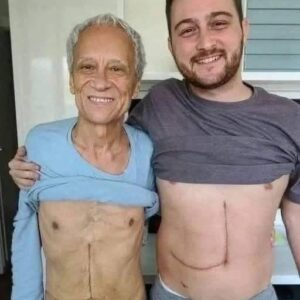Victoria Wright was born with cherubism, an extremely uncommon genetic disorder. The first indications of an abnormal bony overgrowth in the lower region of her face appeared when she was four years old. The cause was initially unknown to the doctors.
Wright’s face is as hefty as a bowling ball, according to the experts. She experienced bullying at school and even on the bus as she grew older. Victoria, however, was adamant about living life to the fullest and never allowing the bullies to triumph. She is now a fantastic spokeswoman and role model. Here is a glimpse into her life and current appearance.
The fact that each of us has a distinct appearance is, in fact, what makes us interesting and special. Some people are tall, some are short, some gain weight readily, and some refuse to gain weight even with poor eating habits. Each of us has a distinct color of hair, or none at all. Everybody has characteristics that set them apart.
Additionally, newborns with particular diseases, disorders, or odd facial features are born every year. Although it can undoubtedly make life more difficult, those with these distinctive facial features are actually the bravest and strongest of us all.
Victoria Wright – born with cherubism
Victoria Wright is one someone to whom this undoubtedly applies. Cherubism, a rare genetic disorder characterized by varying degrees of aberrant bony outgrowth on the lower region of the face, was present in her from birth. She consequently endured bullying at school and was given a variety of derogatory nicknames; even now, as an adult, she continues to hear degrading remarks.
Victoria, however, would never allow the bullies to prevail. Rather, she became a global role model who chose to use comedy to illustrate to the world what it’s like to live with a facial impairment. Her amazing tale is worth telling, and we hope you will tell your friends and family about this piece!
When Victoria Wright was born, she was just like any other baby. Everything appeared to be ideal, and her parents were overjoyed for their cherished daughter. However, everything changed one day when she was four years old.
“My mum was brushing my teeth, and she noticed they weren’t in the right place,” Victoria Wright told NHS.
The earliest indications of cherubism, a rare genetic disorder characterized by varying degrees of aberrant bony development of the lower face, have emerged. It was named for the chubby-cheeked angelic figures that are frequently seen in Renaissance art.
When Victoria and her family visited doctors, they were told that cherubism had been found. The Wrights were informed that following adolescence, Victoria’s condition would deteriorate. But as we now know, it did not occur.
As an alternative, Victoria Wright’s jaw widened, and it soon started to damage her eyes. The strain on her eyes increased in intensity. There came a time when action was required.
Suffered from bullying everywhere she went
Her eyesight was preserved via surgery to reduce the pressure. She still gets headaches, though, because of her vision impairment.
“Cherubism isn’t a painless condition. I do get twinges of pain. My head is very heavy. Doctors say it’s as heavy as a bowling ball,” Wright explained.
“I’ve been offered surgery on my jaw to make it smaller, but I don’t think it would improve my appearance. I’m used to the way I look.”
After Victoria Wright began attending school, her life got difficult. She detailed how she was subjected to verbal abuse, intimidation, threats of violence, and bullying on the street and public transportation in an article she wrote for The Guardian.
At school, kids gave each other names like Fat Chin, Buzz Lightyear (the Toy Story astronaut), and Desperate Dan (a wild west figure from the Scottish comic book The Dandy).
“A girl used to draw pictures of me in class and share them around,” Victoria said.
People were staring at Victoria everywhere, whether she was on the bus, at school, or just strolling down the street. She eventually realized that the looks were simply human, but she never became accustomed to them.
“I try not to take it too personally. We all stare, even me,” Wright said.
OFF THE RECORD Doctors Left Shocked When Her Chin Won’t Stop Growing—What She Looks Like Today Is Amazing
Victoria Wright was born with cherubism, an extremely uncommon genetic disorder. The first indications of an abnormal bony overgrowth in the lower region of her face appeared when she was four years old. The cause was initially unknown to the doctors.
Wright’s face is as hefty as a bowling ball, according to the experts. She experienced bullying at school and even on the bus as she grew older. Victoria, however, was adamant about living life to the fullest and never allowing the bullies to triumph. She is now a fantastic spokeswoman and role model. Here is a glimpse into her life and current appearance.
The fact that each of us has a distinct appearance is, in fact, what makes us interesting and special. Some people are tall, some are short, some gain weight readily, and some refuse to gain weight even with poor eating habits. Each of us has a distinct color of hair, or none at all. Everybody has characteristics that set them apart.
Additionally, newborns with particular diseases, disorders, or odd facial features are born every year. Although it can undoubtedly make life more difficult, those with these distinctive facial features are actually the bravest and strongest of us all.
Source: Freepik
Victoria Wright – born with cherubism
Victoria Wright is one someone to whom this undoubtedly applies. Cherubism, a rare genetic disorder characterized by varying degrees of aberrant bony outgrowth on the lower region of the face, was present in her from birth. She consequently endured bullying at school and was given a variety of derogatory nicknames; even now, as an adult, she continues to hear degrading remarks.
Victoria, however, would never allow the bullies to prevail. Rather, she became a global role model who chose to use comedy to illustrate to the world what it’s like to live with a facial impairment. Her amazing tale is worth telling, and we hope you will tell your friends and family about this piece!
When Victoria Wright was born, she was just like any other baby. Everything appeared to be ideal, and her parents were overjoyed for their cherished daughter. However, everything changed one day when she was four years old.
“My mum was brushing my teeth, and she noticed they weren’t in the right place,” Victoria Wright told NHS.
The earliest indications of cherubism, a rare genetic disorder characterized by varying degrees of aberrant bony development of the lower face, have emerged. It was named for the chubby-cheeked angelic figures that are frequently seen in Renaissance art.
When Victoria and her family visited doctors, they were told that cherubism had been found. The Wrights were informed that following adolescence, Victoria’s condition would deteriorate. But as we now know, it did not occur.
As an alternative, Victoria Wright’s jaw widened, and it soon started to damage her eyes. The strain on her eyes increased in intensity. There came a time when action was required.
Suffered from bullying everywhere she went
Her eyesight was preserved via surgery to reduce the pressure. She still gets headaches, though, because of her vision impairment.
“Cherubism isn’t a painless condition. I do get twinges of pain. My head is very heavy. Doctors say it’s as heavy as a bowling ball,” Wright explained.
“I’ve been offered surgery on my jaw to make it smaller, but I don’t think it would improve my appearance. I’m used to the way I look.”
After Victoria Wright began attending school, her life got difficult. She detailed how she was subjected to verbal abuse, intimidation, threats of violence, and bullying on the street and public transportation in an article she wrote for The Guardian.
At school, kids gave each other names like Fat Chin, Buzz Lightyear (the Toy Story astronaut), and Desperate Dan (a wild west figure from the Scottish comic book The Dandy).
“A girl used to draw pictures of me in class and share them around,” Victoria said.
People were staring at Victoria everywhere, whether she was on the bus, at school, or just strolling down the street. She eventually realized that the looks were simply human, but she never became accustomed to them.
“I try not to take it too personally. We all stare, even me,” Wright said.
“As a teenager, I used to get angry, but that doesn’t do any good to you or the person staring. It just reinforces the stereotype that people with disfigurements must be angry, tragic, or scary. If I find myself being stared at in an aggressive way, it can be unsettling. But I don’t let it get to me.”
She continued, “If someone’s staring out of curiosity, I just smile and nod to show them I’m a human being and there’s nothing to be scared of. Most of the time, people smile back. That’s a good feeling, because I know I’ve made a small connection with them.”
Victoria Wright – ‘Changing Faces’
When Victoria Wright became a teenager, her life changed. She discovered the charity Changing Faces, which has now become the UK’s leading charity for people with a scar, mark, or condition on their face or body. Founded in 1992, their website says they “provide life-changing mental health, wellbeing, and skin camouflage services” and “work to transform understanding and acceptance of visible difference, and campaign to reduce prejudice and discrimination.”
Victoria received a lot of support in Changing Faces. The foundation was essential in helping her understand that, in spite of her facial impairment, she was as valuable as everyone else, in addition to her family, friends, and teachers at school.
“As a teenager meeting them, I felt, ‘Wow, you can have a career and be happy and confident with a disfigurement,” she told NHS.
“Sometimes you can feel isolated, especially if you have a rare condition. It’s difficult if you don’t see anybody else in the street like you. Getting peer support is so important. For every person who stares, there are a hundred others who don’t and who will like and respect you for who you are.”
Changing Faces gave Wright a fresh outlook on her life. She started to see the bright side and even made a joke about how she looked. She said she “adores” Buzz Lightyear from Toy Story and considers him to be her sibling in an interview with 60 Minutes Australia.
Many have asked why Victoria doesn’t “do something” with her face by getting plastic surgery. Because of it, she has also been misrepresented in the media as being opposed to cosmetic surgery.
In actuality, though, Victoria Wright has nothing against cosmetic surgery. She demonstrates that she is content with her appearance, which is the most important thing.
“I’m not going to change myself to make other people happy”
“I’m certainly not against people with disfigurements having surgery, but I’m fine with the way I look. Why should I have the surgery for other people?” Victoria Wright asked.
“I’m happy with my face most days. After all, I’m a woman, and no woman is completely happy with the way she looks. But I’m not going to change myself to make other people happy.”
She added, “I don’t want to hide at home, afraid to go out and afraid of other people. If they have issues about how I look, it’s their problem, not mine.”
Victoria Wright gained even more recognition in 2016 after appearing in the BAFTA-nominated comedy-drama mockumentary Cast Offs. For a fake reality show, it followed six disadvantaged individuals who were transferred to a secluded British island.
It featured a paraplegic man, a blind man, and Victoria, who has cherubism, of course. Every role was portrayed by a disabled actor with the same disability, according to The Guardian, and one actor even voiced dissatisfaction at the prevalence of non-disabled actors playing disabled people:
“There is likely to be a storm of comment from disabled people and non-disabled people alike over Cast Offs. Some disabled people will find it funny and real – portraying disabled people as adults who swear, drink, and have sex. A real break from covering disability with kid gloves or not covering it at all. Others may well find it offensive,” Liz Sayce, chief executive of the Royal Association of Disability Rights, told the newspaper.
Being a part of the show was an incredible experience for Victoria. Additionally, filmmakers Miranda Bowen and Amanda Boyle shared a brief but compelling tale about her during a Q&A session she hosted. She had chosen to make it funny once more.
Victoria Wright was born with cherubism – this is her today
“I remember in your casting Victoria, you had to invent a secret. You claimed that you’d had plastic surgery to become funny-looking. I remember the look on the face of the person you were acting with. It was a brave, bold, and funny moment – everything we were looking for,” Boyle said.
Miranda added, “I often forgot that neither of you [Victoria and co-star Peter Michell] had acted before. You both performed with great professionalism and proficiency, and it was a joy working with such a talented group of actors.”
Victoria Wright’s life developed joyfully; she is now a devoted mother and an effective advocate for disability rights.
She has also taken up the role of spokesperson for Jeans for Genes, the UK’s annual fundraising campaign for people with genetic conditions.
“Throughout my life, I’ve met people who assume that because of how I look, I must live a depressing, isolated life, but I have a good life. I’m a charity campaigner and public relations professional, and I’m blessed with a young daughter who makes me laugh every day,” she said.
Now Trending:
She Was Forced to Marry a Homeless Man — But One Sentence at the Altar Changed Everything
New Mom Recovers From Life-Threatening Delivery—Then Her Husband Gives Her An Ultimatum
At 90 This Old Man Amazed The World By Building His Own Hobbit House, But Wait Till You See Inside
Please let us know your thoughts and SHARE this story with your Friends and Family!





